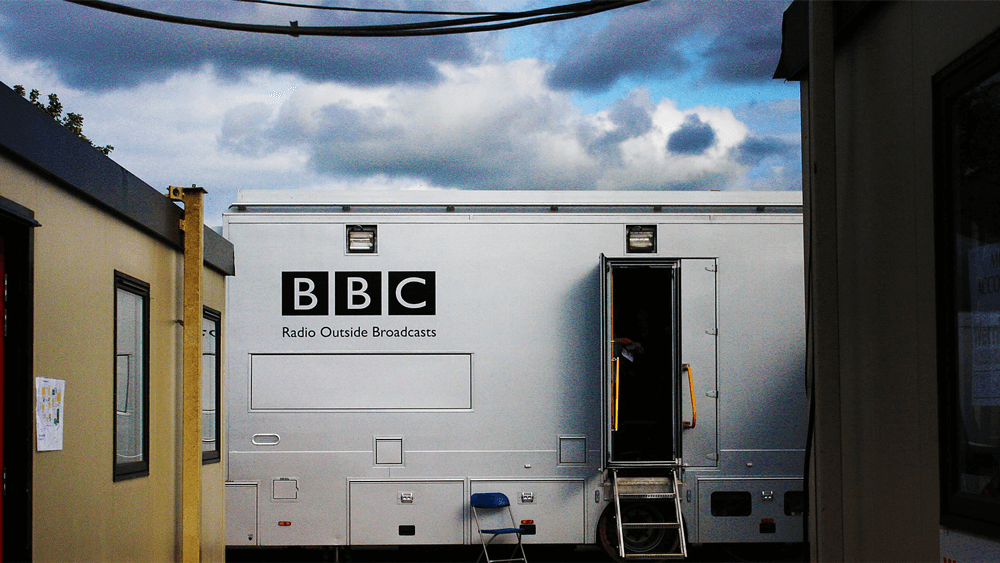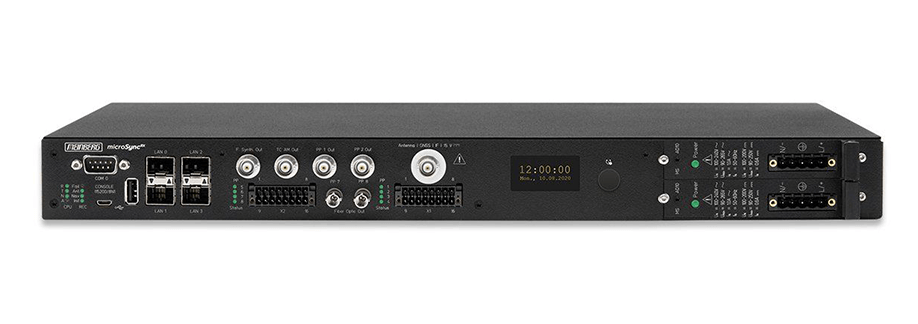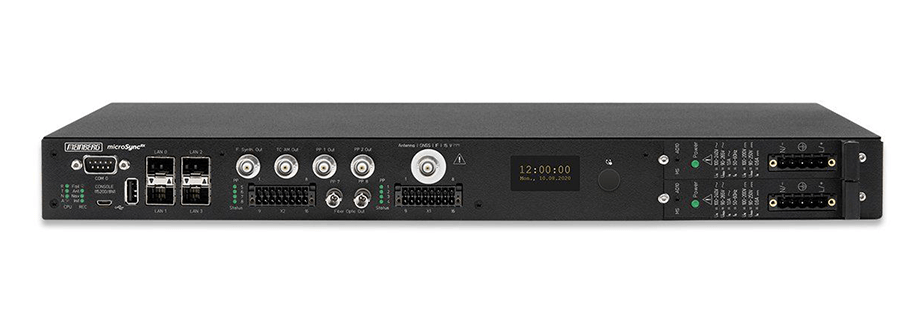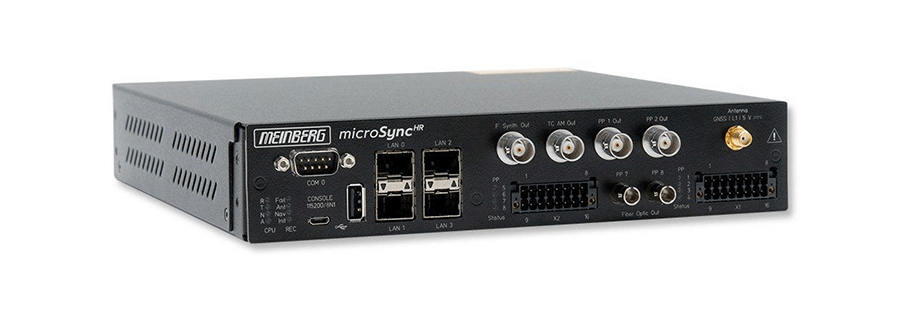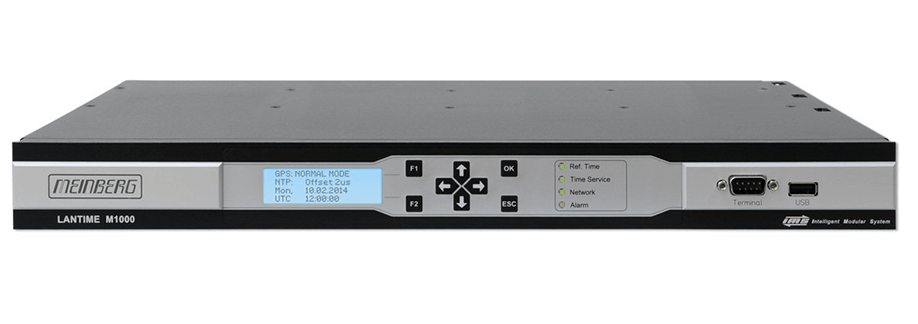SDI vs IP Broadcast Systems
Navigating the Transition from SDI to IP and Mastering PTPv2 for Seamless Production
The Outside Broadcast (OB) industry has experienced dramatic change over the last few years, with increasing demands for high quality live broadcasting and expanding viewership requiring new technology to fulfil these demands. A key piece of technology that is enabling this transformation is Internet Protocol (IP) broadcasting.
Serial Digital Interface synchronisation (SDI) has been the default of professional broadcasting for years and is still used today in many studio environments. However, the industry now seeks greater flexibility, scalability, and cost-effectiveness, driving the integration of IP. This transition not only transforms production workflows but also supports the broader digital and cloud-based broadcasting trends.
In this article, we will explore the advantages and disadvantages of both SDI and IP-based networks for outer broadcast and time synchronisation.
Content overview:
-
What is Outside Broadcast (OB)
-
Time Synchronisation in Outside Broadcast
-
The transition from legacy SDI systems to a virtualised, IP-based environment
- PTP – How it works and it’s historical use in the Broadcasting industry
- How does SDI compare against PTPv2?
- PTP Protocol in Broadcast Networks
- When to consider using IP instead of SDI
-
High-Performance PTP Grandmasters for Broadcast Networks
-
Meinberg microSync 700 family
-
Meinberg Lantime M1000
-
What is Outside Broadcast (OB)?
Outside Broadcasting (OB) is the recording and transportation of live TV outside of a traditional broadcasting studio, taking the broadcast setup to the event itself, and allowing live coverage of sports, concerts, or breaking news from wherever it is happening.
Time Synchronisation in Outside Broadcast
Time synchronisation in outside broadcast (OB) is crucial for ensuring that all audio and video signals are aligned for seamless playback and accurate representation of the event being captured. Desynchronisation of Audio and video is highly noticeable, with anything more than 40 Milliseconds lag being noticeable to the average viewer.
Like main broadcasting studios, outside broadcasting made use of multiple SDI signals for synchronisation such as Bi Sync/Tri-Sync, Word Clock and LTC. These signals required a separate distribution architecture to the main broadcasting data, taking up valuable space and adding additional weight and cost to the installation inside OB trucks.


The transition from legacy SDI systems to a virtualised, IP-based environment
IP Synchronisation allowed the synchronisation to be provided on the same central infrastructure as the rest of the broadcasting data, reducing the need for a separate synchronisation architecture, and therefore reducing weight and space requirements for the OB truck.
As a result of this, outside broadcast operations were among the first to embrace the SMPTE ST 2110 (Society of Motion Picture and Television Engineers) standards for transmitting audio, video and metadata over IP networks once they were ratified.
An additional benefit of this adoption of IP for broadcasters was that OB trucks, as seen in Figure 1, are much more cost-effective to construct and install than full IP studios. This made them ideal testing grounds for the new IP-based technologies before being integrated into large-scale traditional studios.
PTP – How it works and it’s historical use in the Broadcasting industry
Within a network, PTP works by exchanging specific messages across the network between a Master/Leader clock and a Slave/Follower. The standard exchange mechanism for PTPv2 can be seen in Figure 2.
The delays over the network can then be calculated and adjusted for to obtain the best synchronisation possible.
The audio domain has utilised IP synchronisation since the mid-2000s with DANTE, using the PTPv1 protocol for synchronising audio over IP networks where traditional SDI signals like word clock were not practical to install.
For PTPv2, it took a few years before it gained traction with AES-67, the audio PTPv2 profile being published in 2013, 5 years after PTPv2 was introduced. The Video synchronisation PTPv2 profile, ST2059-2 was published 2 years later in 2015.
How does SDI compare against PTPv2?
SDI signals, due to their unidirectional nature, are rather simple to configure when compared to PTPv2. They typically require a direct connection from the signal generator to the receiving end device or a connection through a distribution amplifier.
This straightforward setup, combined with the stable frequency of SDI signals, provides an uncompressed, highly accurate and stable synchronisation between the source and the receiving equipment.
The accuracy of the synchronisation is actually higher than PTPv2 if installed correctly, as SDI only has to contend with the attenuation of the cable, whereas PTPv2 needs to adjust for constantly changing network conditions and path delays.
The downside of SDI is that you require separate signals for the frequency synchronisation and the time of day information needed by most equipment. In SDI, the time of day information would be provided by a protocol called Linear Time Code (LTC) alongside BiSync/TriSync and word clock.
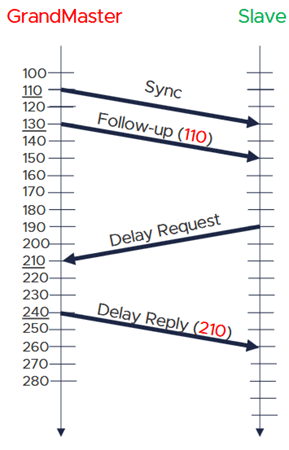

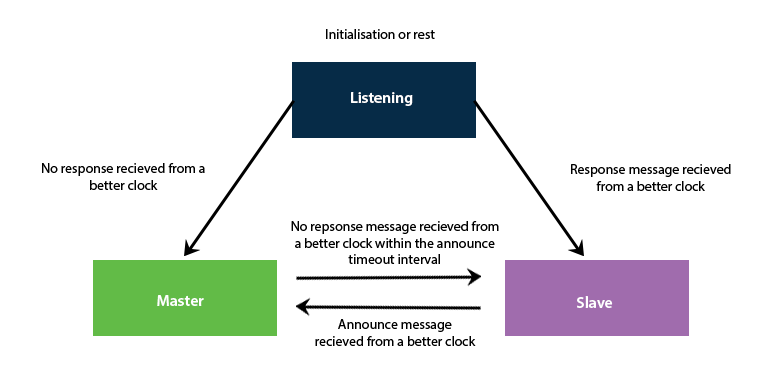

PTP Protocol in Broadcast Networks
On the other hand, IP protocols operate bidirectionally, requiring the correct configuration of Grandmaster Clocks, Boundary Clocks and end devices for optimal performance.
This requires all equipment being used to be PTPv2 compliant to enable the protocol to accurately assign delay values across the network. The fewer compliant pieces of equipment that are integrated, the more jitter is introduced and the less stable the synchronisation becomes.
Another key benefit of an IP integration in OB is the redundancy for synchronisation.
As seen in Figure 3. PTPv2 has a built-in mechanism for redundancy, the BMCA or Best Master Clock Algorithm. This algorithm uses communication between multiple Grandmaster capable clocks on the network and performs a ‘voting’ procedure to compare the characteristics of each clock to select the best one to use on the network.
All other clocks not being used will enter a passive mode until something happens to the grandmaster to cause a new vote. This allows multiple backup clocks to be installed, which can take over as soon as the primary clock fails.
This voting system can be rigged to have a very specific failover order and always have one chosen clock be the grandmaster in a network, however, for OB applications this is not recommended.
When to consider using IP instead of SDI
It depends!
Integrating IP is not always cost effective, especially if an environment already has an existing SDI infrastructure. Where IP does have an advantage of SDI though is for:
- Large-scale productions
When dealing with numerous video sources and complex routing requirements, IP networks provide greater scalability and flexibility. - Remote production
IP enables efficient transmission of video signals over long distances, facilitating remote production workflows. - Integration with IT infrastructure
IP can leverage existing IT networks and infrastructure, potentially reducing costs.
Through:
- Scalability
IP networks can easily accommodate a larger number of video streams and higher resolutions due to their inherent scalability, while the number of dedicated cables and ports available limits SDI. -
Flexibility
IP allows for dynamic routing of video signals across the network, enabling flexible workflows and the ability to connect devices from different manufacturers more easily compared to SDI's point-to-point connections. -
Bidirectional communication
IP networks allow for two-way communication, enabling features like remote camera control and return video feeds on the same cable, unlike unidirectional SDI. -
Lower cable count
A single IP cable can carry multiple video streams, reducing the need for a large number of dedicated SDI cables.
Historically, OB environments have relied on Serial Digital Interface (SDI) for transporting video and audio signals, with SDI routers playing a crucial role in signal routing. Many broadcasting studio’s already have an SDI backbone in place, and removing this and installing a completely new IP infrastructure does not make financial sense.
The best approach we see within the industry is a hybrid approach.
Utilising existing SDI backbone infrastructure, and using boundary clocks to synchronise to the SDI signals, and then converting this into PTPv2 profiles for use in newly built areas of the studio or testing environments.
As the broadcast industry transitions to IP, our team of experts, with over 20 years of experience in specifying and designing bespoke timing systems, is ready to assist you in selecting the right equipment and providing expert guidance. As a leading UK and Ireland distributor of PTP-compliant switches, Grandmaster clocks and Slave devices, APC offer comprehensive advice and support on implementing future-proofed timing solutions for your broadcast needs.
High-Performance PTP Grandmasters for Broadcast Networks
microSync 700 - Ideal for broadcast applications where high precision, compact size and a balance of performance and cost are essential
The Meinberg microSync 700 family are a popular choice amongst time synchronisation in broadcast applications due to their high precision and accuracy as PTP Grandmasters, ensuring seamless alignment of audio and video streams.
Meinberg's microSync 700 series devices are robust and reliable, designed to withstand demanding broadcast environments. They support key industry standards like SMPTE ST 2059-2 and AES67, offering flexibility and adaptability to diverse broadcast needs.
Read more about the Meinberg microSync family here.
LANTIME m1000 - Suited for larger, more complex networks and demanding applications requiring higher performance, scalability and a wider range of customisation options
The Meinberg LANTIME M1000 is well-suited for outdoor broadcast applications due to its rugged design, high precision, and robust synchronisation capabilities. Its compact and weatherproof enclosure allows for reliable operation in challenging outdoor environments, while its GPS/GNSS receiver provides accurate time and frequency signals, essential for maintaining the synchronization and timing critical for broadcast equipment.
Learn about Meinberg's range of GNSS reference clocks, offered as modules for Meinberg's family of modular IMS systems (M1000).


About the Author
Rob Skinner
Technical Sales Executive at APC Technology Group
As a member of our Time division at APC Technology Group, Rob Skinner is an expert in the field of time synchronisation. With over 10 years of experience in the timing industry, specifying and designing bespoke timing systems, Rob has gained a diverse skillset by working across 9 different industries with specific timing requirements.
Contact us
Our team of experts have over 20 years of experience specifying and designing bespoke timing systems. As one of the UK and Ireland’s leading distributors of PTP-compliant switches, Grandmasters and Slave devices, our team can advise and support on a wide range of future-proofed timing system

